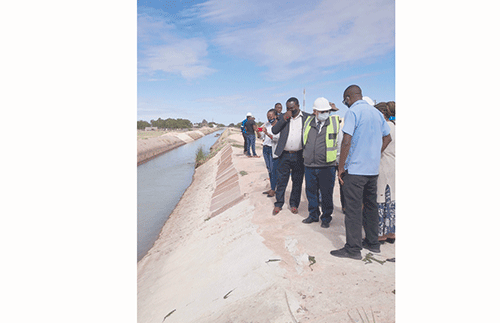Ignatius Nambundunga
Over a stretch of 150km from the highlands of southern Angola to the flat surfaces of central-northern Namibia lies an open, concrete stretch of water.
The Calueque-Oshakati Canal was commissioned in 1976 by the colonial Portuguese administration in Angola and its counterpart, the South African apartheid government, in present-day Namibia, a tool of appeasement for the drought-stricken local populace and a strategic point during the infamous bush war in northern Namibia.
This 150km long Calueque- Oshakati canal runs from Angola to Oshakati in Namibia. Water that flows in the canal emanates from the Calueque dam, located on the Cunene River in southern Angola.
Apart from providing water to over 100 000 households in the most densely populated areas of Omusati and Oshana regions, the canal also serves as an important geographical point of reference, readily used as a contour demarcation for villages, therefore making the work of traditional authorities easier, which translates as a good political tool for possible local conflict mitigation insofar as land delimitation is concerned.
The canal, which is vital for the subsistence farming population of northern Namibia, ranges from accessibility to consistent water supply for domestic consumption, horticulture, aquaculture and leisure activities in the form of swimming by especially school-going children.
Today, 33 years after the demise of the iron-fisted coloniser, many young locals living on the periphery of the canal are fully utilising that proximity to their advantage to derive economic benefits for themselves and their families. One such farmer is David Andreas (38) from Okapya.
Okapya is a small village in the Ogongo constituency of the Omusati region, lying in the semi-arid savannah expanses, and it is situated about 80km from Oshakati, the commercial hub of northern Namibia.
In 2017, armed only with hoes, picks, spades, a few other hand tools, a National Diploma in Agriculture from the University of Namibia and sheer determination, with the help of friends, David dug a pipeline from the water point to his home, a distance of about 720 metres.
Like many farmers who pump water from the canal, Andreas uses a gasoline-powered water pump to tap water from the canal to his garden, one hector of farmland, where he harvests a range of produce, such as onions, tomatoes, green peppers and cabbages.
Andreas told New Era he draws inspiration from the farmers at Olushandja Dam around Epalelela in the Ruacana constituency, who are among the first lot to start farming along the canal.
“During the harvest season, which is between May and August, I employ between four to six people on a temporary basis to help with harvesting,” he says.
David produces about 9.5 tonnes of tomatoes and 1 500 heads of cabbage, which he sells in the nearby villages from the back of his Nissan bakkie.
“Although the harvest is good, we usually face challenges such as low water supplies at times and persistent attacks from insects. I am lucky to have both the practical and theoretical know-how, as I am a graduate in the field of agriculture from the Unam Ogongo Campus, a few kilometres from my garden,” David lamented.
Like David, 30-year-old Maria Magdalena Phillemon, a single mother of two and a holder of a degree in Logistics and Supply Chain Management from the Namibia University of Science and Technology (NUST), also aspires to be a successful commercial farmer in future.
Her journey is not different to an average rural farmer.
Maria has a plantation at Onampira in the Okatana constituency of Oshana region.
Phillemon observed the disruption in the supply chain of commodities as a result of Covid-19 and decided to set up a garden at her late father’s homestead.
She produces different crops, chief amongst them tomatoes and cabbages.
Phillemon plans on planting maize in July to supplement her tomatoes and cabbage farming.
“Vegetables will always be in demand, as people would always eat and want to lead a healthy lifestyle,” she said, emphasising the need for food security.
Not all rosy
However, not everything is rosy either, as they face many challenges, such as the cost of living, insects, stratospheric cost increases of fertilisers, access to markets and a serious lack of technical expertise to run their gardens.
“Our main challenges are disease control mechanisms and lack of funds. We fund ourselves, as we have no proper access to funds from central government. The costs of fertilisers are also skyrocketing,” David said.
“If I had money, I would buy a water solar pump and water tanks so I could increase my output,” said the bubbly farmer, Phillemon.
Andreas and Phillemon cite a lack of capital as a major challenge in the upkeep of their farming activities.
Have they had enough funding, they said, they would employ more people and subsequently become full-time farmers.
“I use a gasoline-powered water pump generator to draw water from the canal. Since the price of petrol has gone up, I use about N$600 per week – that is one of the challenges I am facing,” Phillemon said.
There is also a cloud of uncertainty around the canal, with many community members fearing the planned work to revamp the canal may interrupt access to the water supply; therefore, hindering their businesses.
Namwater will spend around N$93 million to rehabilitate 5.8km of the canal.
Speaking to New Era, headman of Okapumbu village Junias Andjene said, “There are rumours of completely revamping the canal to make it a pipeline that is underground; that will affect many of the villagers, as we rely on it for domestic water use and also to water our gardens. It will be a very bad situation for those who want to keep farming and to sustain themselves,” he said.
– inambundunga@nepc.com.na



